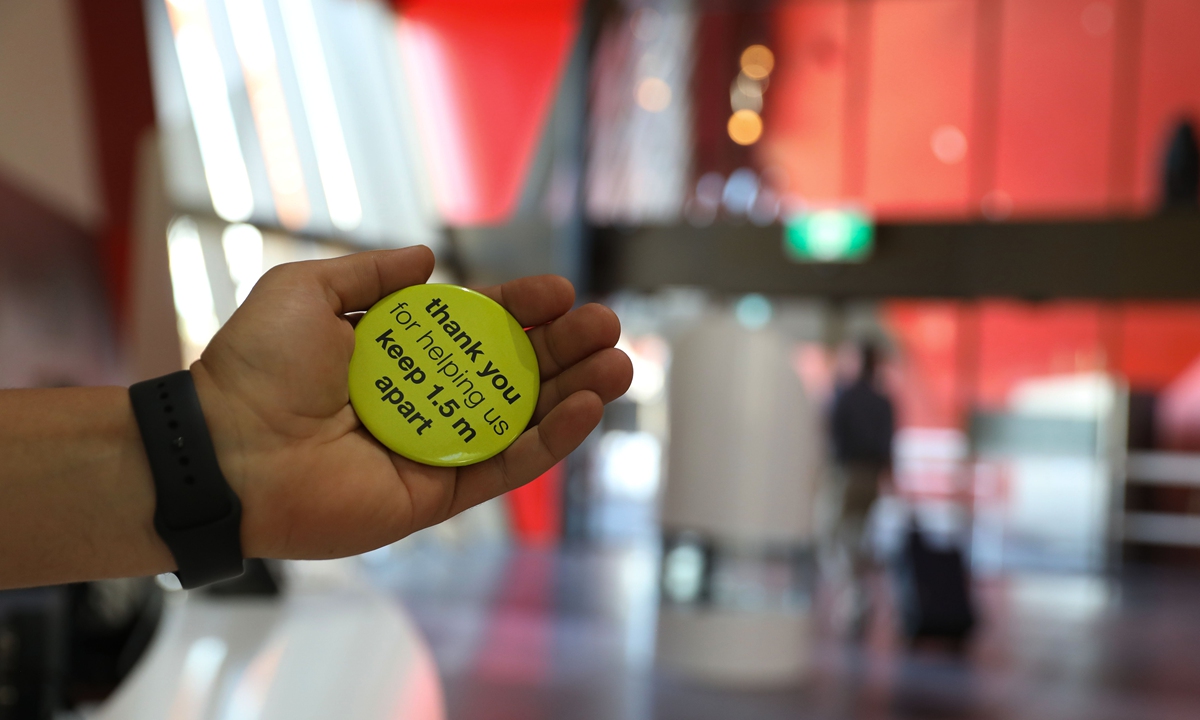Sail away
Source:Xinhua Published: 2020/6/8 18:03:40

A pin reminding visitors to maintain social distancing at the National Museum of Australia on June 2 Photo: Xinhua
After a further easing of restrictions in Australia, people in the capital city of Canberra are able to follow Captain James Cook's footsteps 250 years ago and learn more about his voyage in a delayed exhibition at the National Museum of Australia (NMA).
The exhibition, Endeavour Voyage: The Untold Stories of Cook and the First Australians, immerses visitors in the moment when the First Australians encountered James Cook and his crew in 1770.
"This exhibition tells a really epic story," said Shona Coyne, curator of the exhibition.
"Actually it's a foundation of story that's been rooted in Australia for a very long time."
It was scheduled to begin in April. Just a few weeks before its launch, Australia announced the COVID-19 restrictions and museums, galleries and libraries closed.
NMA reopened on June 2.
However, Coyne said that the COVID-19 pandemic forced them to alter their plan.
"For instance, some of the objects were from international lenders, so we have had to replace them with facsimile."
"That's a bit disappointing, but the great thing is we are actually able to make them much larger and brighter so people can actually get a closer look at some of the objects," she added.
Expanding on the often one-sided narrative associated with the Endeavour story, this new exhibition honors both Cook's great voyage of scientific and geographic exploration and the rich Aboriginal and Torres Strait Islander culture that has thrived in Australia for at least 65,000 years.
On the wall there are artworks by indigenous artists from a small community south of the Cooktown. According to Coyne, after ship Endeavor crashed into the Great Barrier Reef, local residents then went to the beach, picked up driftwood and created artworks on top of them.
"So some of these pieces might have been bits of the ship that had splintered off and washed up on the bay," she said.
"And then there are some botanical specimens as well," said Coyne.
On the other side of the wall there are displays showing places named after the event, from Cook Place to Endeavor Street.
"The voyage has been remembered and recorded in place names and in monuments," said Coyne.
While people are still concerned about COVID-19, measures have been taken to ensure their safety.
A labyrinth game simulates Cook's sailing through the Great Barrier Reef, which was like a maze. Visitors can use a wheel to get a ball through the maze to the other side.
"We have installed the hand sanitizer, so whenever you use an interactive, you can clean your hands before and afterwards, and then have fun with the activities we've created," she said.
"Actually we have a task force go around each one of the interactive activities and make sure we had certain measures in place," Coyne said, noting that at the drawing station, all the pencils are for single use only and visitors can take them home.
She told the Xinhua News Agency that the museum also uses a booking system to control the number of people allowed into the exhibition space.
Garrett Turtill found out about the exhibition online while staying at home during the restrictions. When he learned that the museum was to open to the public again, he registered for the exhibition.
"It was really easy, very quick," said the 70-year-old man.
"You just get a ticket on your phone, and you bring it in and they wave you through."
Turtill said he was excited both to be out of doors and to be at the exhibition.
"I am very interested in early maritime exploration around Australia," he said.
"And I am satisfied with the museum's measures as well as local government's handling of coronavirus. That's why I felt confident to come out to the exhibition," he added.
According to the original plan, the exhibition will run until this October. But the museum said it might extend it until the beginning of 2021.
Posted in: ART,CULTURE & LEISURE